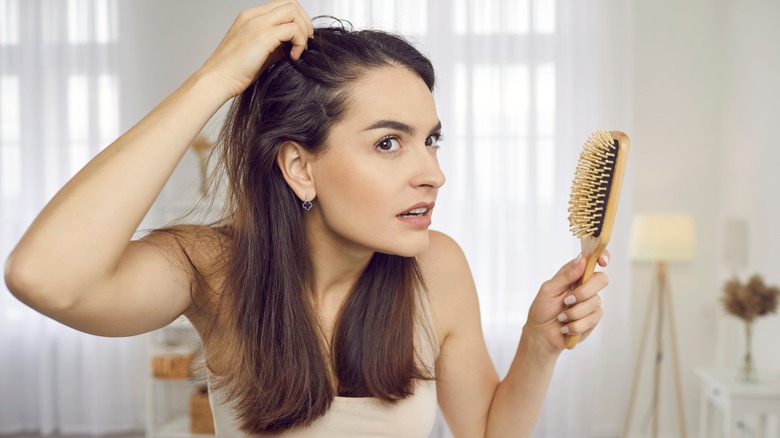Hair loss can be stressful and can be a source of anxiety, especially when it’s caused by the way you style your hair and other items. While it’s a great method of communicating your thoughts, paying attention to your hair’s health is vital.
This article will go over the causes of hair loss that are connected to styling, provide strategies to prevent hair loss, discuss Rogaine, and recommend hair-friendly styles.
Understanding the Reasons:
Extreme use of heated devices such as straight irons, twisting wands, and levelers could damage hair follicles and result in breakage
Compound Medicines: The unforgiving nature of synthetics with colors, relaxers, and perms can weaken the shaft of hair, causing it to be vulnerable and more prone to breakage.
The tight hairstyles that you wear: Continually wearing tight twists, pig tails, or buns could create pressure on hair follicles and cause the condition known as foothold alopecia.
Items Develop: Using products for styling, such as gels, hairsprays, and waxes, can clog from opening up the pores of the scalp, which can block the development of healthy hair.
Preventive Actions:
Limit the intensity of styling.g Utilize heat styling equipment with the lowest temperature setting that you can, and then consistently apply a splash of intensity protection ahead of styling.
Choose a delicate hair product. Make sure to use shampoos without sulfates and conditioners. Limit the use of drugs that contain substances.
Use the wide-tooth or detangling brush for gentle elimination of the hair’s tangles. Try not to pull hair.
Cut Hair: Do not wear tightly-fitting hairstyles for a long time, and choose looser hairstyles to lessen stress on your scalp.
Cleanse Scalp Regularly: Use an explanation cleanser every week to prevent the development of items and ensure that the scalp remains healthy.
Choose hair-accommodating: frills that are suitable for use with hair accessories made of delicate materials such as silk or silk, to prevent the possibility of breaking and contact.
Rub the scalp: Regular scalp rubs may help create blood flow, which can lead to the growth of hair and reduce the rate of balding.
Hairstyle Options That Fit Your Hair Type:
Air Drying: Allow your hair to dry completely at any time that you can to minimize the harm caused by heat. Styles for defensive use: Use defensive styles such as plaits, twists, or buns that don’t apply excessive stress on your scalp.
The Heatless Styling Method: Examine using techniques that are not heated, such as weaving or winding your hair in short-term for natural-looking hairstyles, such as twists or waves.
Do-it-yourself hair remedies: Make use of common fixings like avocado, coconut oil, or honey to make supportive hair covers that increase durability and adaptability.
The cause of balding that is caused through styling techniques and products calls for a delicate mix of hair care habits and careful hair styling choices.
If you focus on your hair’s health and make small adjustments to your daily routine, you will enjoy gorgeous, healthy hair, without having to settle on a style. Remember, just a little extra thought will make all the difference in maintaining your lovely locks for the foreseeable future.
The Part Hormonal Shifts Play in Hair Loss
Hair loss is a frequent concern for some. If hereditary characteristics and aging play an important role, hormone changes can also contribute to this particularity. Understanding the significance of chemical compounds to the health of your hair is essential to preventing and controlling hair loss effectively. We’ll explore the complex relationship between hormonal fluctuations and the loss of hair, providing insight into the underlying systems and providing information on possible options for treatment.
Hormonal Factors Contributing to Hair Loss:
Androgens Testosterone, along with its subordinate, dihydrotestosterone (DHT), can bind to receptors on the scalp, leading to a reduction in hair follicles as well as steady diminution, particularly in people with a genetic predisposition.
Estrogen: While estrogen is a major contributor to hair growth and thickness, fluctuations in estrogen levels, such as those experienced during menopausal or pregnancy, could disrupt the balance and lead to hair loss.
Thyroid Chemicals issues that are described as a lopsidedness in thyroid chemical levels may cause a range of hair-related issues, such as weakness, thinning, and excessive loss.
Methods of Treatment:
Chemical Substitution Therapy (HRT) for those experiencing hair loss due to menopausal or hormonal imbalances. HRT may assist in returning hormonal harmony and improve hair health.
Affirmation of Androgen Treatment: Medications like finasteride or spironolactone could block the effects of androgens on the scalp, slowing down hair loss and encouraging growth.
Thyroid Administration Treatment of thyroid problems, hidden by medicine or chemical substitute treatments, can aid in reducing the loss of hair due to thyroid irregularities.
A healthy diet that includes an appropriate diet rich in essential nutrients like iron, vitamins (especially Biotin and Vitamin D), and protein will help to maintain hair health generally and minimize the effects of hormonal fluctuations on hair loss.
Conclusion:
Hormonal changes have a significant impact on the growth cycle, which affects the strength and thickness as well as the overall strength of hair. If we understand the role of hair-destroying chemicals and implement a specific treatment plan as time draws near, we can effectively manage the normal concerns and have healthy, Rogaine, solid locks throughout the course of their lives.
Speaking with a medical-skilled dermatologist or dermatologist will give personalized experiences and advice tailored to your specific needs, ensuring the best results when it comes to the quest for healthy hair.

